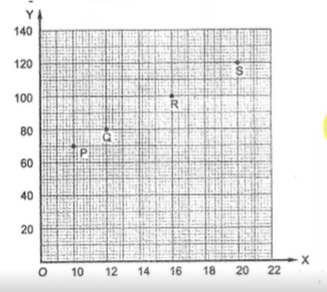On shifting the origin to (p, q), the coordinates of point (2, –1) changes to (5, 2). Find p and q.
The correct Answer is:p=-3,q=-3
To solve the problem, we need to find the values of p and q when the origin is shifted from the point (0,0) to the point (p,q). The given coordinates of the point change from (2,−1) to (5,2).
1. Understanding the Shift of Origin:
When we shift the origin from (0,0) to (p,q), the relationship between the old coordinates (x,y) and the new coordinates (X,Y) can be expressed as:
x=X+p
y=Y+q
2. Substituting the Given Coordinates:
We know the old coordinates (x,y)=(2,−1) and the new coordinates (X,Y)=(5,2). We can substitute these values into the equations:
- For the x-coordinate:
2=5+p
- For the y-coordinate:
−1=2+q
3. Solving for p:
Rearranging the first equation to solve for p:
p=2−5
p=−3
4. Solving for q:
Rearranging the second equation to solve for q:
q=−1−2
q=−3
5. Final Result:
Therefore, the values of p and q are:
(p,q)=(−3,−3)
Conclusion:
The new origin after shifting is at the point (−3,−3).
When we shift the origin from (0,0) to (p,q), the relationship between the old coordinates (x,y) and the new coordinates (X,Y) can be expressed as:
x=X+p
y=Y+q
We know the old coordinates (x,y)=(2,−1) and the new coordinates (X,Y)=(5,2). We can substitute these values into the equations:
- For the x-coordinate:
2=5+p
- For the y-coordinate:
−1=2+q
Rearranging the first equation to solve for p:
p=2−5
p=−3
Rearranging the second equation to solve for q:
q=−1−2
q=−3
Therefore, the values of p and q are:
(p,q)=(−3,−3)
The new origin after shifting is at the point (−3,−3).
Topper's Solved these Questions
- STRAIGHT LINES Book:CBSE COMPLEMENTARY MATERIALChapter:STRAIGHT LINES Exercise:SECTION-C (SHORT ANSWER TYPE QUESTIONS)
Explore 15 Videos
- STRAIGHT LINES Book:CBSE COMPLEMENTARY MATERIALChapter:STRAIGHT LINES Exercise:SECTION-D (LONG ANSWER TYPE QUESTIONS )
Explore 23 Videos
- STRAIGHT LINES Book:CBSE COMPLEMENTARY MATERIALChapter:STRAIGHT LINES Exercise:SECTION-A (TRUE/FALSE)
Explore 6 Videos
- STATISTICSBook:CBSE COMPLEMENTARY MATERIALChapter:STATISTICSExercise:Section - D (Long Answer Type-II Questions) (6 Mark)
Explore 10 Videos
- TRIGONOMETRIC FUNCTIONS Book:CBSE COMPLEMENTARY MATERIALChapter:TRIGONOMETRIC FUNCTIONS Exercise:SHORT ANSWER TYPE QUESTIONS
Explore 62 Videos
Similar Questions
Knowledge Check
If by shifting the origin at (1,1) the coordinates of a point P become (cosθ,cosϕ) then the original coordinates of P were
A(2cos2θ/2,2cos2ϕ/2)B(2sin2θ/2,2sin2ϕ/2)C(2cosθ/2,2cosϕ/2)D(2sinθ/2,2sinϕ/2)
when the origin is shifted to a point P, the point (1,-3) changed to(4,-7), then P :
View SolutionThe coordinates of the point P are (−3, 2) . Find the coordinates of the point Q which lies on the line joining P and origin such that OP=OQ .
View SolutionFor what value of p the point (p,2) lies on the line 3x+y=11? If the coordinates of two points are P(−2,3)andQ(−3,5), then find (abscissa of P) - (abscissa of Q).
View SolutionIf the origin is shifted to the point (0,-2) by a translation of the axes, the coordinates of a point become (3, 2). Find the original coordinates of the point.
View SolutionIf the origin is shifted (1,2,−3) without changing the directions of the axis, then find the new coordinates of the point (0,4,5) with respect to new frame.
View SolutionFind the projection of the point (1,0) on the line joining the points P(-1, 2) and Q (5, 4).
View SolutionIf the origin is shifted to the point (2,-1) by a translation of the axes, the coordinates of a point become (-3,5). Find the original coordinates of the point.
View Solution
